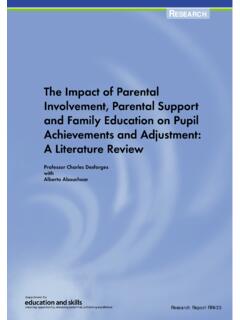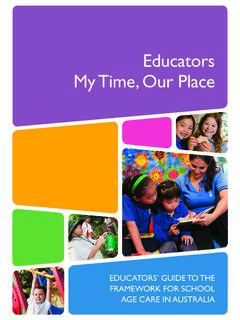Transcription of The Work Sampling System
1 The Work Sampling System 16/11/13 11:49 AMThe Work Sampling System is an instructional assessment that is used in preschool through third grade. Its purpose is to document and assess children s skills, knowledge, behavior, and accomplishments across a wide variety of curriculum areas on multiple occasions in order to enhance teaching and Work Sampling System consists of three complemen-tary elements:1) Developmental Guidelines2) Developmental Checklists3) Summary ReportsThe Work Sampling System calls for ongoing assessment that is summarized three times per year.
2 By reflecting classroom goals and objectives, it helps teachers moni-tor children s continuous progress and places children s work within a broad developmental perspective. Through documenting and evaluating individual performance of classroom-based tasks, Work Sampling strengthens student motivation, assists teachers in instructional decision mak-ing, and serves as an effective means for reporting children s progress to families, educators, and the 26/11/13 11:49 AMPreschool-3 Developmental Guidelines5th EditionMargo L. DichtelmillerJudy R.
3 JablonDorothea B. MarsdenSamuel J. MeiselsThe Work Sampling System 36/11/13 11:49 AMPsychCorp is an imprint of Pearson Clinical Executive Office 5601 Green Valley Drive Bloomington, MN 55437 Copyright 2013 NCS Pearson, Inc. All rights reserved. Portions of this work were published in previous guidelines may be reproduced for personal use and not for resale or , the PSI logo, PsychCorp, The Work Sampling System , The Work Sampling System logo, and Work Sampling are trademarks in the and/or other countries of Pearson Education, Inc., or its affiliate(s). Bristle Blocks is a registered trademark of Battat, Inc.
4 Duplo and LEGO are registered trademarks of the LEGO Group. Play-Doh is a registered trademark of Hasbro. McDonald s is a registered trademark of McDonald s Corporation and its affiliates. Scotch is a registered trademark of of The Work Sampling System was supported in part by a grant from the John D. and Catherine T. MacArthur Foundation. The opinions expressed are solely those of the in the United States of orders and inquiries: 47/19/13 1:48 PMvPreschool-3 Guidelines Introduction ..viiI Personal and Social Development ..1 A Self-Concept ..1 B Self-Control.
5 1 C Approaches to Learning ..2 D Interaction With Others ..3II Language and Literacy ..5 A Listening ..5 B Speaking ..6 C Reading ..7 D Writing ..8 Language and Literacy for English Language Learners ..8 A Listening for English Language Learners ..8 B Phonological Awareness for English Language Learners ..9 C Speaking for English Language Learners ..9 III Mathematical Thinking ..11 A Processes and Practices ..11 B Number ..11 C Operations and Algebraic D Measurement ..12 F Geometry ..13IV Scientific Thinking ..15 A Inquiry Skills and Practices.
6 15 B Physical Science ..16 C Life Science ..17 D Earth Science ..18V Social Studies ..19 A People, Past and Present ..19 B Human Interdependence ..19 C Citizenship and Government ..20 D People and Where They Live ..20VI The Arts ..21 A Expression and Representation ..21 B Understanding and Appreciation .. 56/11/13 11:49 AMviThe Work Sampling SystemVII Physical Development, Health, and Safety ..23 A Gross Motor Development ..23 B Fine Motor Development ..23 C Self-Care, Health, and Safety .. 66/11/13 11:49 AMviiPreschool-3 GuidelinesIntroductionThis volume presents the Work Sampling System Developmental Guidelines for Preschool-3 (age 3) in an edition designed for classroom use.
7 For general reference use, the complete text of this edition, along with the Guidelines for five other grade levels, is included in the Work Sampling System Omnibus Guidelines (Preschool through Third Grade).The Work Sampling System s Developmental Guidelines are designed to enhance the process of observation and to ensure the reliability and con-sistency of teachers observations. The Guidelines incorporate research, expert advice, and state and national standards, including Common Core. All resources used in the formulation of the Guidelines are listed in the Teacher s to Read the GuidelinesThe Guidelines present each specific skill, behavior, or academic accom-plishment in the form of a one-sentence performance indicator.
8 Each indi-cator is followed by a rationale and several specific examples. The rationale provides a context that explains the meaning and importance of the indicator and briefly outlines reasonable, end-of-the-year expectations for children of different ages. The examples show several ways children might demonstrate the skill, knowledge, or accomplishment represented by the indicator. These are intended to give teachers a concrete picture of the many different ways children might show their skill or ability in rela-tion to the indicator. Examples are not attributes or behaviors that need to be checked off as necessary in order to demonstrate proficiency.
9 Since different teachers may interpret the same indicator in different ways, the Guidelines promote consistency of interpretation and evaluation across children, teachers, and the examples provided for each indicator suggest a variety of ways that children show their skills and knowledge, they do not exhaust all the ways children demonstrate what they know and can do. The students in any particular classroom may show their knowledge in other ways, re-flecting their unique backgrounds, interests, and classroom opportunities. We expect that our examples will serve as a catalyst to help teachers think of the range of situations in which children demonstrate specific skills and knowledge, and to understand and evaluate their students performance within the context of their classrooms.
10 Other examples that are more con-sistent with an individual teacher s curriculum approach can be 76/11/13 11:49 AMviiiIn the Guidelines, we have attempted to provide illustrations that are rel-evant to teachers who work with diverse groups of children. Examples that relate specifically to the development of children with special needs are included to suggest how teachers might assess children with disabilities who are included in regular classrooms. Rather than providing examples related to specific cultural or linguistic groups, we have tried to use inclusive or general language to accommodate children from various cultural, linguis-tic, economic, and social backgrounds.





